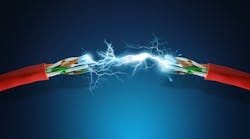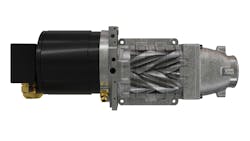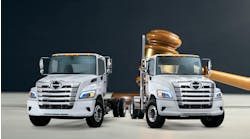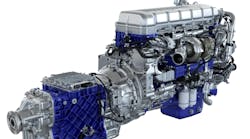Partnership was a common theme—if not the top theme—that permeated this year’s Advanced Clean Transportation (ACT) Expo. As the industry moves closer toward this heavily publicized sea change of electrification, fleets, OEMs, and suppliers alike are looking to work better together rather than in the traditional siloes they may have been used to.
Over the last six years or so, Meritor, which has a 110-year legacy as a supplier of drivetrain, mobility, braking, aftermarket, and powertrain solutions for commercial vehicles, has developed an electric powertrain and partnered with various OEMs to put real-world miles on it.
Amid those real-world demonstrations, Ameya Jathar, Meritor’s senior product engineer, pointed out during an ACT Expo workshop that as fleets are starting to learn about electric vehicles, their range anxiety is very real, so they are asking for larger battery packs, which inevitably add weight to the vehicle. He also said that fleets testing electric vehicles today seek opportunities to recharge during unloading or during lunch breaks—but charging infrastructure is scarce.
In order for all of this to work in the actual real world, Tim Bowes, SVP and president of Industrial and North America Aftermarket for Meritor, told FleetOwner that it really starts with a basic understanding of applications and vehicle range.
“I think this is going to evolve,” Bowes said. “You have short-haul, drayage, and certain applications where this is going to work really well. Medium, middle ground, and long-haul range is a little further out, but we are closer to it. The trick will be total cost of ownership and understanding that TCO tipping point.”
To move the electrification needle, particularly in a climate of material shortages and lingering impacts from the pandemic, industrywide relationships are evolving at a rapid pace. Partnerships have become even more important in the wake of economic, material, shipping, and labor issues in the market.
“We’ve been as creative as we can be, but quite frankly, I think all these discussions are brewing as to how we can work with our key core customers and how we manage it all together because I don’t see this abating anytime soon,” Bowes said.
Over the last couple of years, Meritor acquired California-based Transportation Power Inc. (TransPower), which now operates under Meritor’s Global Electrification unit. Transpower supplies integrated drive systems, full electric truck solutions, and energy-storage subsystems to manufacturers of trucks, school buses, refuse vehicles, and terminal tractors. Meritor has partnered with Paccar as the non-exclusive supplier of electric powertrains for Peterbilt and Kenworth tractors. Meritor also supplied 14Xe electric axles for Freightliner's Innovation Fleet and has a production contract with Kalmar Ottawa to supply terminal tractors.
Most recently, Meritor added Hyliion to its list of partners. Meritor will provide the electric drivetrain for Hyliion’s Hypertruck ERX. Hyliion’s powertrain system will feature Meritor’s Blue Horizon 14Xe e-powertrain drive axles as the standard position propulsion and regeneration hardware on Hyliion vehicle upfits.
Government partnerships
Going back to 2015, fleet electrification was still uncertain and was more of a science project, explained Mihai Dorobantu, director of Technology Planning and Government Affairs at Eaton. Eaton, which has a strong tie with regulatory agencies, began looking at its portfolio and considering ways to transition for an electric future. And in 2018, Eaton formed a business segment called eMobility.
“We significantly increased R&D spending and partnerships with agencies like the Department of Energy and Department of Defense to establish what was then a key market, and those investments started to accumulate,” Dorobantu explained. “We looked at our portfolio and our transmission business—half our sales were coming from transmissions. We decided to reposition that business. We formed a joint venture with Cummins and that allowed us to grow faster.”
When it comes to partnerships, Eaton has worked closely with the U.S. Department of Defense to develop solutions for the electrification of some military vehicles, which have similar specs to off-road and vocational vehicles.
Eaton also just announced its Vehicle Group has partnered with fuel system manufacturer Ballard Fuel Cell Systems and the Department of Energy’s National Renewable Energy Laboratory (NREL) to develop heavy-duty truck fuel cell technology. The partnership is the result of a grant Eaton’s Vehicle Group received from the U.S. Department of Energy to develop hydrogen fuel cells capable of powering heavy-duty machinery. The new fuel cell technology will leverage Eaton’s Twin Vortices Series technology to improve fuel efficiency.
“We co-located some of our advanced R&D at NREL, and that location allows us to run numerous programs,” Dorobantu told FleetOwner. “NREL’s benefit is that their scientists get exposed to real-world problems, and they can develop solutions that have legs. This is pretty unique in the realm of renewable energy.”
In the commercial vehicle space, it’s no secret that charging infrastructure is the biggest barrier to widespread fleet electrification. Dorobantu noted that manufacturers are finding out that it’s easy to sell one or two electric vehicles, but if they need to sell 10 or 20, the end customer, or fleet, must consider rewiring their facility and upping their electric consumption to accommodate charging. And that’s a major undertaking.
Based on Eaton’s power electronics expertise, the microgrid technology, and the company’s ability to manage power from electrical sources, Dorobantu said Eaton has begun to ramp up partnerships with OEMs that are providing electric vehicles and charging solutions.
When asked if he believes diesel fueling stations will eventually be converted to electric, Dorobantu said it’s plausible.
“Do I foresee that happening in 2050? Sure,” he said. “Will that be the case in 2040? I don’t think so. The reason is that it’s hard to beat the energy density of diesel. The only way you can really beat it is with hydrogen, and we are very far away from hydrogen infrastructure. Until then, I think we will see more and more penetration of these medium-duty commercial vehicles.”
And when it comes to charging infrastructure and who bears the cost, Dorobantu said that’s a question that society at large will have to ask itself.
“It would be unfair to burden the transportation sector with the burden of bearing the cost to produce green transportation electricity,” he explained. “That’s a much broader national priority type of question.”






